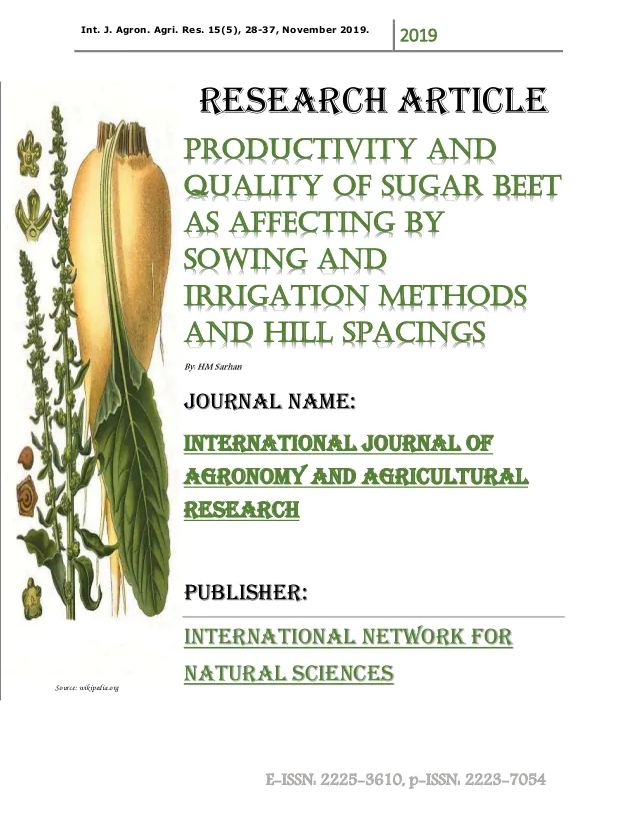An agricultural
research journal called International Journal of Agronomy and Agricultural
Research (IJAAR) published an articles entitled “Productivity and quality of sugar beet as affecting by sowing and
irrigation methods and hill spacings” in the November Issue 2019, under
volume 15. This research work developed by Mr. HM Sarhan from the Sugar Crops Research Institute, Agriculture
Research Center, Giza, Egypt.
Abstract
Two field experiments were carried out at Kalabsho Experimental Farm, Dakahlia Governorate, Sugar Crops Research Institute, Agricultural Research Center, Egypt, during 2014/2015 and 2015/2016 seasons to study the effect of sowing methods (mechanical and manual methods), irrigation methods (surface and drip irrigation system) and hill spacings (10, 15 and 20cm between hills) on yield and its components, as well as quality of sugar beet cv. Hossam as a multigerm variety under sandy soil conditions. The obtained results could be summarized as follows; the optimum sowing method that produced the highest values of yield and its components as well as root quality parameters was mechanical sowing method (planter machine) in both seasons. Irrigation sugar beet plants by using drip irrigation system yielded the highest values of yield and its components as well as root quality parameters and followed by using surface flooding irrigation system in both seasons. Planting sugar beet seeds on one side of the ridge, 60cm width, and 20cm between hills, resulting plant population density 35000 plants/fed produced, the highest values of yield and its components and root quality parameters and followed by planting on 15cm between hills, resulting plant population density 46666 plants/fed and finally planting on 10cm between hills, resulting plant population density 70000 plants/fed in the two seasons. From the obtained data in this study, it can be concluded that sowing sugar beet using mechanical sowing method (planter machine), irrigation by using drip irrigation system and planting on one side of the ridge, 60cm width, and 20cm between hills, resulting plant population density 35000 plants/fed in order to maximizing its productivity and quality under the environmental conditions of sandy soil in Kalabsho region, Dakahlia
Governorate, Egypt.
Materials and methods
The present investigation was carried out at
Kalabsho Experimental Farm, Dakahlia Governorate, Sugar Crops Research
Institute, Agricultural Research Center (ARC), Egypt during 2014/2015 and
2015/2016 seasons to study the effect of sowing and irrigation methods and hill
spacings on yields and its components as well as quality of sugar beet cv.
Hossam as a multigerm variety under sandy soil conditions Each sowing method
(mechanical and manual) was performed in separate experiment. Mechanical sowing
method was done by using planter machine in ridges 60cm in width. However,
manual sowing method was undertaken workers in ridges 60cm in width.
Each experiment of sowing method was performed
in strip-plot design with three replicates in both seasons. The vertical-plots
were occupied with two irrigation methods (surface and drip irrigation system).
The plots were irrigated immediately after sowing by surface flooding method in
both irrigation methods. After that, in surface flooding irrigation method,
plants were irrigated after sowing regularly every 15-18 days. In the drip
irrigation system, polyethylene drip lines of 16mm in diameter had in-line type
emitters. The distance between emitters along the drip line was 0.20m and the
discharge of one emitter was 4L/h under the running pressure of 1.5 atm.
Read More: Research Paper Published by Agricultural Research Journal on Effectiveness of two diatomaceous earths (FossilShield® and SilicoSec®) against Sitophilus zeamais Motschulsky | IJAAR
The horizontal-plots were devoted at random with
three hill spacings (10, 15 and 20cm between hills) on one side of the ridge.
Plants were thinned at the age of 45 days from sowing to obtain one plant/hill,
resulting three plant population densities of 70000, 46666 and 35000
plants/fed, respectively.
Each experimental basic unit included ten
ridges, each 60cm apart and 3.5 m length, which resulted an area of 21 m2
(1/200 fed).
Soil samples were taken at random from the
experimental field area at a depth of 0-30cm from soil surface and prepared for
both mechanical and chemical analyses. The results of both mechanical and
chemical analyses are presented in Table 1.
The experimental field well prepared by two
ploughing, leveling, compaction, division and then divided to the experimental
units. Calcium super phosphate (15.5% P2O5) was applied during soil preparation
at the rate of 200kg/fed.
Sugar beet balls (seeds) were sown using
mechanical and manual methods as previously mentioned at the first week of
November in both growing seasons. Nitrogen fertilizer (100kg N/fed) in form of
urea (46.5%) was applied in three equal doses, the first portion was applied
after thinning (45 days from sowing), the second portion was applied after 60
days from sowing, and the third portion was applied after 75 days from sowing.
Potassium sulphate (48% K2O) at the rate of 24kg/fed was applied after 30 days
from sowing.
Other agricultural practices for growing sugar beet were performed as recommendations by Ministry of Agriculture, except the factors under study. Interested reader can get full articles by following link Int. J. Agron. Agri. Res. 15(5), 28-37, November 2019.
Productivity and Quality of Sugar Beet as Affecting by Sowing and Irrigation Methods and Hill Spacings-IJAA... by International Network For Natural Sciences on Scribd

















0 comments:
Post a Comment